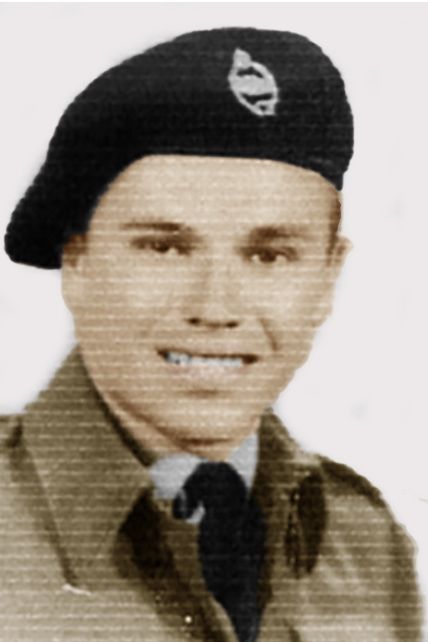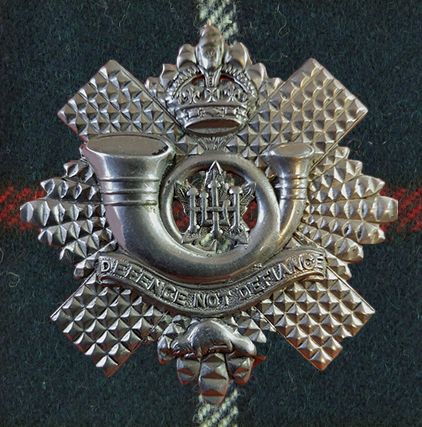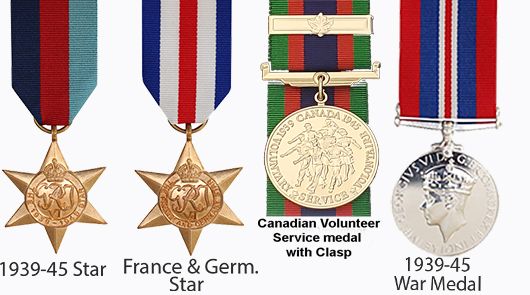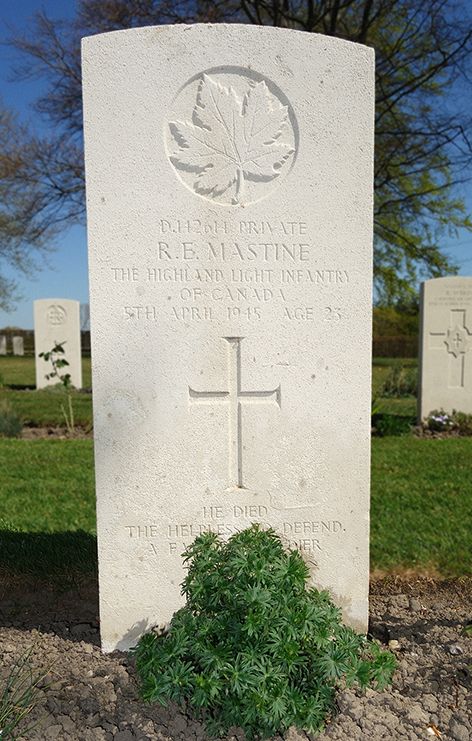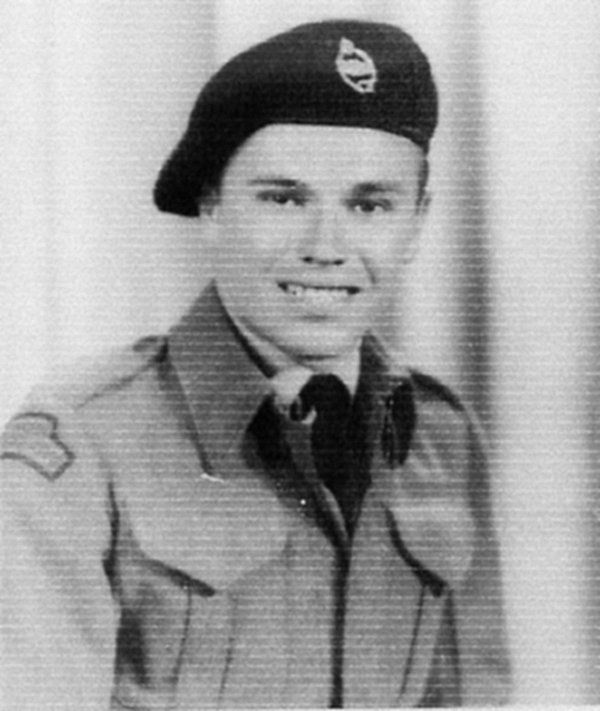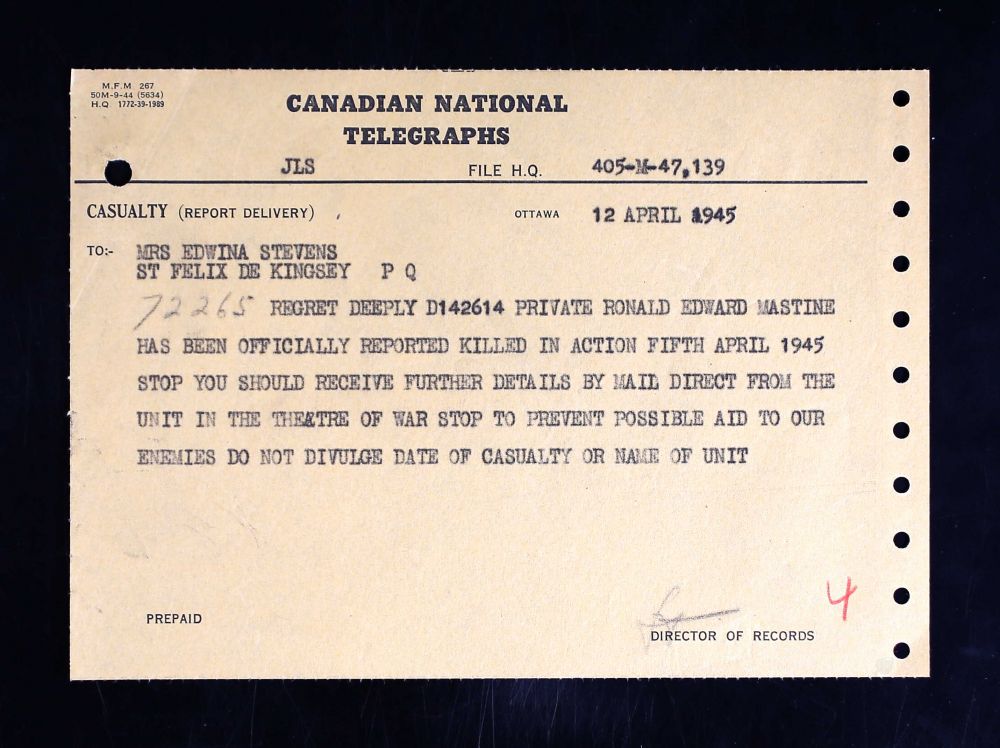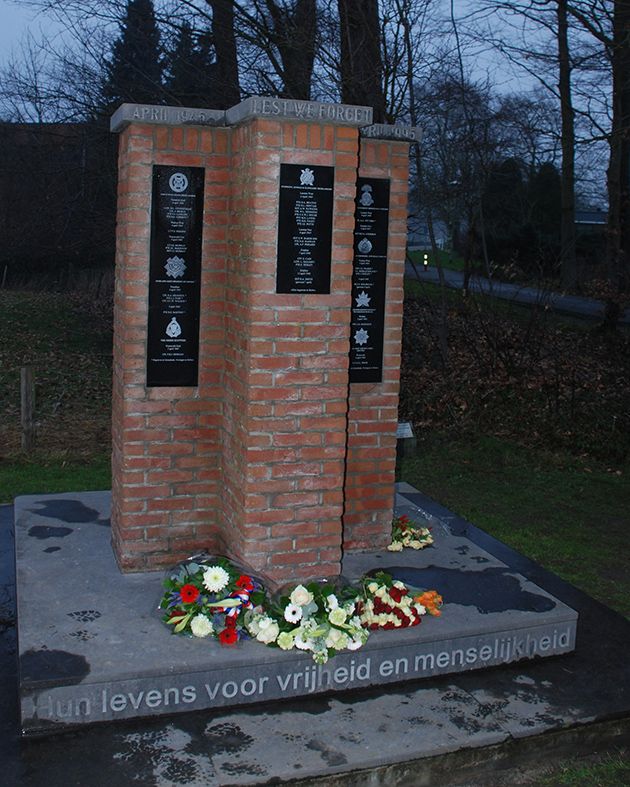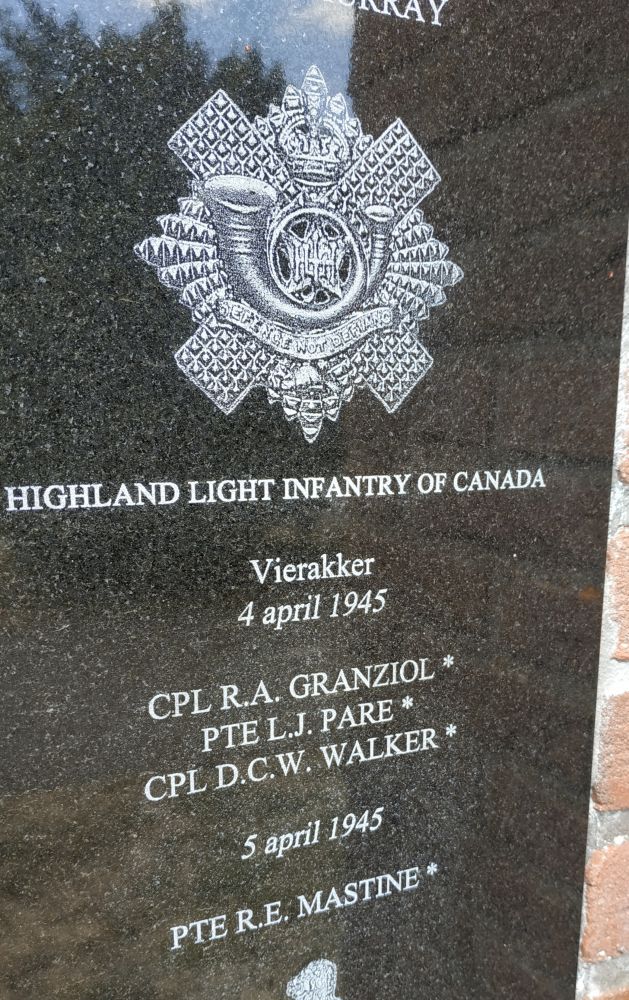Private
Mastine, Ronald Edward
Service nummer D/142614
Overleden 1945-04-05
Leeftijd 23
The Highland Light Infantry of Canada
Ronald Edward Mastine werd geboren op 10 december 1921 in St. Felix de Kingsey, County Drummond, Quebec, als zoon van Jacob Arthur en Edwina Mastine. Vader Jacob overleed in 1927 vanwege hartproblemen en moeder Edwina hertrouwde met Arthur Stevens. Als gevolg hiervan had Ronald twee broers, twee zussen. en twee halfzussen.
Ronald ging naar de public school toen hij 7 jaar oud was en stopte in groep 8. Hij vond school wel leuk en had weinig verzuim maar ging toch liever op de boerderij van zijn stiefvader werken.
Hij was tweetalig, maar Engels had zijn voorkeur en sprak hij vloeiend. Op de boerderij leerde hij auto en tractor rijden, iets dat hem in zijn diensttijd goed van pas kwam.
Als hobby’s had hij dansen, baseball, schaatsen en beetje lezen. Hij ging graag uit en had een grote vriendenkring waar hij goed mee kon opschieten.
In het voorjaar van 1943 kreeg hij de bof en bij zijn keuring gaf hij aan dat hij sindsdien geregeld last had van duizeligheid en hoofdpijn. Ook had hij soms maagklachten. Wat tevens opviel bij zijn keuring was dat hij wat traag was in zijn spraak en beweging. Hij maakte verder een vriendelijke indruk.
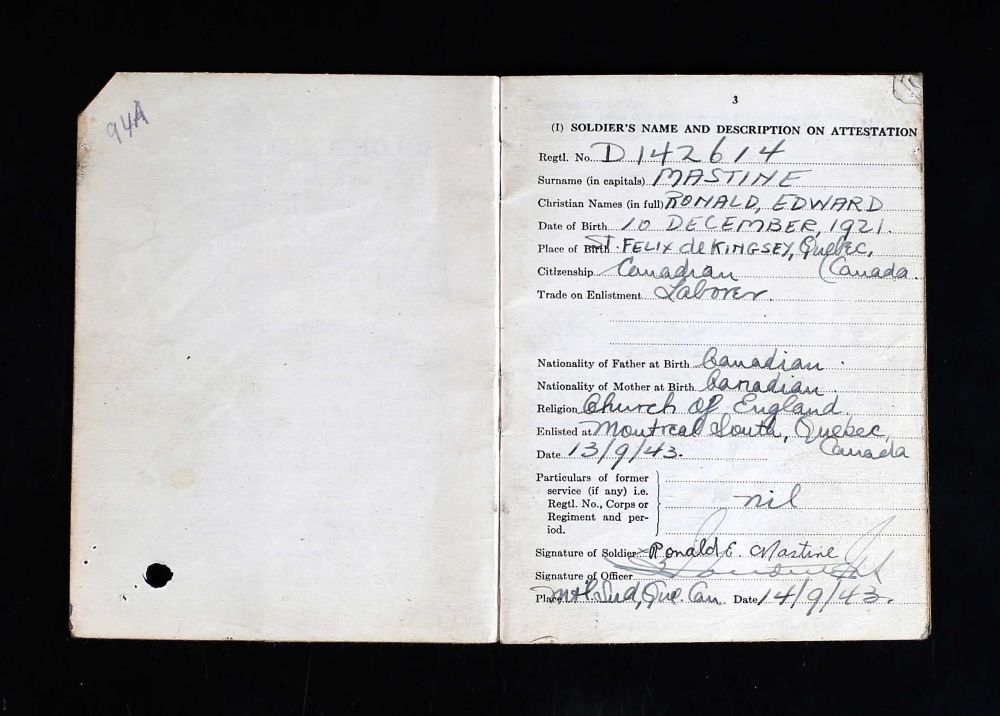
Soldatenboekje -Soldiers Paybook (Bron: Canada, WWII Service Files of War Dead, 1939-1947)
Mastine kwam in dienst op 13 september 1943 in Montreal South, Quebec.
Vanwege zijn ervaring met het rijden in een auto en op de tractor was het advies hem op te leiden tot chauffeur, monteur.
Hij kreeg hiervoor zijn basic training in het #61 Basic Training Center in New Glasgow, N.S. en vervolgtrainingen in Halifax N.S., Windsor N.S., Brampton Ont. en Camp Borden, Ont., waar hij uiteindelijk in juli 1944 zich bekwaamde als Driver Mechanic Group “C” wat hem geschikt maakte om een tank te besturen en voertuigen op banden en rupsbanden.
Begin augustus 1944 werd hij toegevoegd aan de 2nd Canadian Armoured Corps Reserve Unit en vertrok hij naar het Verenigd Koninkrijk waar hij op 10 augustus 1944 aankwam.
Eind augustus maakte Ronald de overstap naar de infanterie en kwam bij de Canadian Fusilliers tot hij op 6 oktober naar Frankrijk werd verscheept en toegevoegd werd aan de X4-lijst van de infanterie, een reservelijst waar regimenten hun verliezen mee konden opvullen.
Uiteindelijk wordt hij op 18 oktober 1944 in België toegevoegd aan de Highland Light Infantry of Canada dat samen met de Stormont Dundas & Glengarry Highlanders en de North Nova Scotia Highlander de 9de Infantry Brigade vormde en die op dat moment verwikkeld waren in de strijd rond de Schelde.
Op 5 april 1945 werd door de Highland Light Infantry of Canada een aanval ingezet op het gebied iets ten zuiden van Huize Vierakker waar de veelal jonge Duitse tegenstanders hevig verzet boden. Maar met ondersteuning van de artillerie werd ook hiermee afgerekend. Letterlijk staat in het oorlogsdagboek geschreven dat een groep verkenners constateerden dat “de vijand was verscheurd door ons het spervuur”.

Kaart met de positie zoals gemeld in het dagboek op 5 april 1945 (Bron: Library and Archives Canada)
Bij de gevechten op 5 april kwam Ronald Edward Mastine om het leven. Hij werd door de 23rd Canadian Field Ambulance overgebracht naar de verbandplaats die zich op dat moment in Beek bevond. Daar werd hij tijdelijk begraven bij de Schutterstent van het St. Jansgilde.
Op 11 maart 1946 kreeg hij zijn definitieve rustplaats op de Canadian War Cemetery in Groebeek, graf XXII. D. 2.

Ronald Edward Mastine was born on December 10, 1921, in St. Felix de Kingsey, County Drummond, Quebec, to Jacob Arthur and Edwina Mastine. Father Jacob died in 1927 due to heart problems and mother Edwina remarried Arthur Stevens. As a result, Ronald had two brothers, two sisters. and two half sisters.
Ronald went to public school when he was 7 years old and dropped out in group 8. He liked school and had little absenteeism, but preferred to work on his stepfather's farm.
He was bilingual, but English was his preference. On the farm he learned to drive a car and tractor, something that served him well during his military service.
His hobbies were dancing, baseball, skating and a little reading. He enjoyed going out and had a large circle of friends with whom he got along well.
In the spring of 1943 he had the mumps and during his examination he indicated that he had suffered from dizziness and headaches since then. He also had stomach problems at times. During the interview, he seemed a little slow in his speech and movement. He also made a friendly impression.

Soldatenboekje -Soldiers Paybook (Bron: Canada, WWII Service Files of War Dead, 1939-1947)
Mastine enlisted on September 13, 1943 at Montreal South, Quebec.
Because of his experience with driving a car and on the tractor, the advice was to train him as a driver, mechanic.
He received his basic training for this at the #61 Basic Training Center in New Glasgow, N.S. and advanced training in Halifax N.S., Windsor N.S., Brampton Ont. and Camp Borden, Ont., where he eventually qualified as Driver Mechanic Group “C” in July 1944, qualifying him to operate a tank and vehicle on tires and tracks.
In early August 1944 he was assigned to the 2nd Canadian Armored Corps Reserve Unit and left for the United Kingdom where he arrived on 10 August 1944.
In late August, Ronald made the transition to the infantry and joined the Canadian Fusilliers until he was shipped to France on October 6 and added to the infantry's X4 list, a reserve list with which regiments could fill their losses.
Finally, on October 18, 1944, he was added in Belgium to the Highland Light Infantry of Canada, which together with the Stormont Dundas & Glengarry Highlanders and the North Nova Scotia Highlander formed the 9th Infantry Brigade and who at that time were involved in the battle around the Scheldt. .
On April 5, 1945, the Highland Light Infantry of Canada launched an attack on the area just south of Huize Vierakker where the mostly young German opponents offered fierce resistance. But with support from the artillery this was also dealt with. Literally written in the war diary, a group of scouts found that “the enemy had been severely mauled by our barrage”.

Map with the position mentioned in the wardiary of april 5, 1945 (Bron: Library and Archives Canada)
Ronald Edward Mastine was killed in the fighting on April 5. He was transferred by the 23rd Canadian Field Ambulance to the dressing station which was located in Beek at the time. There he was temporarily buried at the St. John's Guild Archers' Tent.
On March 11 1946 he was given his final resting place at the Canadian War Cemetery in Groesbeek, grave XXII. D. 2.
